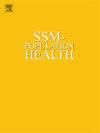从孤立到包容:了解日本LGB+学生的自杀行为和学校支持
IF 3.1
2区 医学
Q1 PUBLIC, ENVIRONMENTAL & OCCUPATIONAL HEALTH
引用次数: 0
摘要
日本的青少年自杀率是全球最高的,这突出表明迫切需要有针对性的预防策略。在这种情况下,学校可以通过塑造身份发展和心理健康结果提供重要的保护因素,但这种保护作用尚未在日本LGB+人群中得到检验。为了解决这一研究空白,本研究调查了过去12个月日本教育环境中LGB+学生自杀意念和自杀企图的相关性。方法通过一项匿名在线调查,对日本15-25岁的2095名LGB+学生进行了多变量logistic回归分析,研究了近期自杀意念和自杀企图与性行为或基于性别的骚扰、排斥和学校支持结构之间的关系。结果过去12个月内自杀意念率(32.3%)和企图率(8.8%)较高。性和基于性别认同的骚扰、排斥和在教育环境中听到关于性的负面言论与更高的自杀意念和自杀企图有关。在教育环境中,支持性的LGBT俱乐部和联盟以及包容LGBT的反欺凌政策与较低的自杀意念率相关。结论该研究结果强调了迫切需要以学校为基础的干预措施,以降低日本LGB+青少年自杀风险的升高。建立安全和支持性的教育环境可能有助于降低这一弱势群体面临的自杀风险本文章由计算机程序翻译,如有差异,请以英文原文为准。
From isolation to inclusion: Understanding suicidality and school supports for LGB+ students in Japan
Introduction
Youth suicide rates in Japan are among the highest globally, highlighting the urgent need for targeted prevention strategies. Within this context, schools can offer significant protective factors by shaping both identity development and mental health outcomes, but such protective effects have not examined in Japanese LGB+ populations. To address this research gap, this examined correlates of suicidal ideation and suicide attempts among LGB+ students in the past 12 months in Japanese educational settings.
Methods
Multivariable logistic regression examined associations between recent suicidal ideation and suicide attempt and experiences of sexuality or gender-based harassment, exclusion, and school support structures among 2,095 LGB+ students aged 15-25 years in Japan from an anonymous online survey.
Results
Results revealed high rates of suicidal ideation (32.3 %) and attempts (8.8 %) in the past 12 months. Sexuality and gender identity-based harassment, exclusion and hearing negative remarks about sexuality in educational settings were linked to higher suicidal ideation and suicide attempts. Supportive LGBT clubs and alliances and LGBT-inclusive anti-bullying policies at educational settings were associated with lower rates of suicidal ideation
Conclusion
The findings highlight the urgent need for school-based interventions to mitigate the elevated risk of suicidality among LGB+ youth in Japan. Establishing safe and supportive educational environments may help reduce the heightened suicide risk faced by this vulnerable population
求助全文
通过发布文献求助,成功后即可免费获取论文全文。
去求助
来源期刊

Ssm-Population Health
PUBLIC, ENVIRONMENTAL & OCCUPATIONAL HEALTH-
CiteScore
6.50
自引率
2.10%
发文量
298
审稿时长
101 days
期刊介绍:
SSM - Population Health. The new online only, open access, peer reviewed journal in all areas relating Social Science research to population health. SSM - Population Health shares the same Editors-in Chief and general approach to manuscripts as its sister journal, Social Science & Medicine. The journal takes a broad approach to the field especially welcoming interdisciplinary papers from across the Social Sciences and allied areas. SSM - Population Health offers an alternative outlet for work which might not be considered, or is classed as ''out of scope'' elsewhere, and prioritizes fast peer review and publication to the benefit of authors and readers. The journal welcomes all types of paper from traditional primary research articles, replication studies, short communications, methodological studies, instrument validation, opinion pieces, literature reviews, etc. SSM - Population Health also offers the opportunity to publish special issues or sections to reflect current interest and research in topical or developing areas. The journal fully supports authors wanting to present their research in an innovative fashion though the use of multimedia formats.
 求助内容:
求助内容: 应助结果提醒方式:
应助结果提醒方式:


